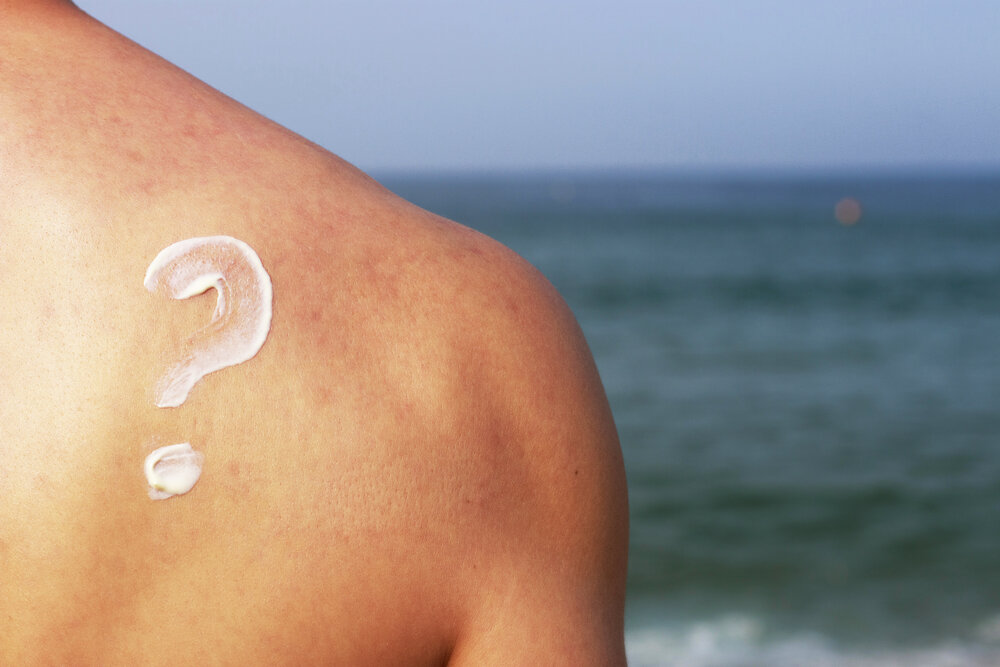With temperatures set to soar and many of us wanting to make the most of it to get our summer glow back, we all know that wearing SPF in the summer months is a must, but how many of us are actually applying it properly?
We have worked with skincare expert Dr Jinah Yoo, a consultant dermatologist at the UK’s leading skincare clinic sk:n, to give us her insight on wearing SPF and protecting our skin as well as answering the top googled questions we all find ourselves searching.
Q: What is the best skincare for sun sensitive skin?
A: Sun-sensitive skin can present as sunburn, prickly heat or make skin conditions like rosacea worse. Protecting the skin from the sun should be the centre of your skincare routine, especially for those with sun-sensitive skin.
Mineral sunscreen containing titanium dioxide and/or zinc oxide, which are very gentle ingredients and suitable for sensitive skin, is preferable than chemical sunscreen. In terms of your routine skincare products, it is best to go for fragrance-free products as fragrances can irritate your skin.
Q: What are the top skincare tips for sunburn?
A: Sunburn will make the skin become red, painful and potentially peel. To reduce the pain and soothe the skin, you can cool down your skin with frequent cool showers or use moisturisers containing aloe vera or soy. If you develop blisters, you need to leave them to heal by themselves, this is so that the blister can be used as a natural dressing and prevent infection.
Q: What skin treatments are available for sun damaged skin?
A: Photo-aged skin can appear in many ways including wrinkles, sagging and pigmentation. If your main concern is photo-aged skin, various treatment including chemical peel, microneedling, lasers, skin lightening creams or topical retinoid cream could be considered, depending on individual’s skin assessment.
As a result of long-term sun damage, rough patches can appear on sun-exposed skin which is called actinic keratosis.
These are considered as precursors of skin cancer and you need to see your GP or a dermatologist to be treated with prescription cream or scraping of the lesion under local anaesthetic injection, depending on the area, size and extent of the sun-damages.
Q: What are the most common mistakes you see people making when using and applying sunscreen?
A: Studies have shown that most people apply less than half of the amount required to provide enough sun protection. If you are using sun lotions, you should apply at least six teaspoons to cover the body of an average adult and half a teaspoon to face and neck.
Q: What exactly happens to the skin when it’s over-exposed to the sun?
A: The dark pigment produced in our skin, called melanin, increases in response to sun exposure. This is in an attempt to absorb UV and protect our skin. Increased production of melanin subsequently can mean skin becomes tanned.
However, in lighter skin types, there is a smaller amount of melanin, meaning that the skin tends to react to UV rather than protecting against it. This means that lighter skin type tends to burn rather than tan.
Q: What are the earliest signs of skin damage which we might not pick up on?
A: Skin can appear dry, flaky and itchy with sun-damage which can be confused with many other skin conditions. Also, it can appear dull with uneven pigmentation, this is a subtle and early sign of skin damage from the sun.
Q: A lot of people wear makeup that contains SPF, is this enough protection for us to not need to reapply throughout the day?
A: Make up with SPF is not a substitute for sunscreen. Make-up or moisturisers with SPF are more likely to be easily removed by water or rubbing and we tend to apply a lot more thinly than sunscreen. Furthermore, SPF is an indicator for UVB protection but does not give protection against UVA.
Q: What is the difference between UVA and UVB rays and how should we protect our skin from both?
A: UVB can cause sunburn and skin cancer whereas UVA is associated with skin ageing and skin cancer. UVA has longer wavelengths than UVB therefore UVA can penetrate through window glasses and deeper to the skin.
To have an adequate sun protection, my advice is to apply sunscreen with SPF 30 or above and UVA star rating of 4 or 5 stars after moisturiser every morning and reapply every two hours when you are going outdoors.
Q: You often see a lot of people on holiday who have applied SPF and it has not been fully absorbed by the skin leaving a white paste on the skin, if you leave it like that are you actually protected?
A: The white appearance from sunscreen comes from the mineral UV filters, such as titanium dioxide, zinc oxide or iron oxide.
These mineral (physical) sunscreens can reflect light from the skin and tend to be less irritating. However, new technologies have meant mineral sunscreens can now have a reduced white appearance and your skin will still be protected with these.
Q: Should we be applying SPF into our scalp?
A: It is not practical to apply SPF to the scalp as it is covered with hairs. Instead wearing a broad-brim hat on a sunny day can help to block the direct sun exposure.
Q: What should we be looking for when buying SPF? They don’t come cheap and can very quickly run out if we are apply them all over our body several times a day when on holiday. Are we ok to buy cheaper brands, or should we be investing in the most expensive ones?
A: Choose the sunscreen which suits your skin type. Expensive sunscreen does not mean that it will suit everyone’s skin. Nowadays, there are many different types of formulation targeting different skin types. If you have acne-prone oily skin, then go for oil-free gel.
When you are buying a sunscreen, it is most important to look at the SPF and UVA star rating to make sure that it has SPF 30 or above and UVA star rating of 4 or 5 stars.
Q: What exactly does the number on SPF products mean?
A: SPF stands for sun protection factor. It refers to the amount of UVB protection the sunscreen offers compared to unprotected skin. For example, SPF15 allows 7% of UVB to reach your skin whereas only 2% reaches your skin with SPF50.
Q: Why do we find that spots appear on the face, chest and shoulders when we apply SPF? Does it clog up our pores?
A: Comedogenic materials in sunscreen can clog up the pores and cause spots. Another possibility is that chemical sunscreens, with ingredients like benzophenones, can cause irritant reaction causing red bumps.
Q: You can buy tanning oils with SPF protection, but does it actually protect you and could you wear this alone on holiday and be safe in the sun and protected?
A: There is no such thing as a truly safe tan other than a fake tan. The goal of a tanning oil is to attract UV to achieve a quick tan, but the goal of SPF is completely opposite – to protect skin against these UV. Most of tanning oils, therefore, do not contain enough SPF to achieve the quick effective tanning.
Q: Are there any common myths or misconceptions about SPF and protecting your skin that you find parents have come to you with?
A: You may have seen some sunscreen advertised as ‘long-lasting’ and requiring only once-a-day application. However, majority of us do not apply adequate amount of sunscreen and we can miss some areas when we apply the sunscreen. Also, it can be accidentally removed by rubbing or sweating throughout the day. Therefore, it is recommended to reapply sunscreen every 2 hours to exposure.





